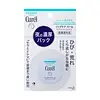What's inside
What's inside
 Key Ingredients
Key Ingredients

 Benefits
Benefits

 Concerns
Concerns

 Ingredients Side-by-side
Ingredients Side-by-side

Paraffinum Liquidum
EmollientCera Microcristallina
Emulsion StabilisingParaffin
PerfumingHydrogenated Polydecene
EmollientDimethicone
EmollientTriacontanyl Pvp
HumectantDipentaerythrityl Tetrahydroxystearate/Tetraisostearate
Skin ConditioningGlycerin
HumectantSqualane
EmollientBrassica Campestris Sterols
EmollientTocopheryl Acetate
AntioxidantSynthetic Wax
AbrasiveEthylene/Propylene Copolymer
AbrasivePolyethylene
AbrasivePolyquaternium-61
Skin ConditioningBHT
AntioxidantParaffinum Liquidum, Cera Microcristallina, Paraffin, Hydrogenated Polydecene, Dimethicone, Triacontanyl Pvp, Dipentaerythrityl Tetrahydroxystearate/Tetraisostearate, Glycerin, Squalane, Brassica Campestris Sterols, Tocopheryl Acetate, Synthetic Wax, Ethylene/Propylene Copolymer, Polyethylene, Polyquaternium-61, BHT
Stearyl Glycyrrhetinate
Skin ConditioningPetrolatum
EmollientParaffinum Liquidum
EmollientHydrogenated Polybutene
Ceresin
Emulsion StabilisingMicrocrystalline Wax
Emulsion StabilisingOctyldodecanol
EmollientPhytosteryl/Octyldodecyl Lauroyl Glutamate
Skin ConditioningAcetamidophenyl Methoxypropionic Acid
EmollientCetyl-Pg Hydroxyethyl Decanamide
Skin ConditioningSimmondsia Chinensis Seed Oil
EmollientAnt Egg Oil Extract
Squalane
EmollientBHT
AntioxidantStearyl Glycyrrhetinate, Petrolatum, Paraffinum Liquidum, Hydrogenated Polybutene, Ceresin, Microcrystalline Wax, Octyldodecanol, Phytosteryl/Octyldodecyl Lauroyl Glutamate, Acetamidophenyl Methoxypropionic Acid, Cetyl-Pg Hydroxyethyl Decanamide, Simmondsia Chinensis Seed Oil, Ant Egg Oil Extract, Squalane, BHT
 Reviews
Reviews

Ingredients Explained
These ingredients are found in both products.
Ingredients higher up in an ingredient list are typically present in a larger amount.
BHT is a synthetic antioxidant and preservative.
As an antioxidant, it helps your body fight off free-radicals. Free-radicals are molecules that may damage your skin cells.
As a preservative, it is used to stabilize products and prevent them from degrading. Specifically, BHT prevents degradation from oxidation.
The concerns related to BHT come from oral studies; this ingredient is currently allowed for use by both the FDA and EU.
However, it was recently restricted for use in the UK as of April 2024.
Learn more about BHTParaffinum Liquidum is also known as liquid paraffin. It is a type of highly refined mineral oil.
Like other oils, Paraffinum Liquidum has emollient properties. Emollients help soothe and soften the skin. By creating a barrier to trap moisture within, emollients help keep your skin hydrated.
Paraffinum Liquidum does not irritate the skin and is non-comedogenic.
Learn more about Paraffinum LiquidumSqualane is an emollient that helps the skin hold onto moisture. It's an oily liquid that occurs naturally in certain types of fish and plant oils.
Because squalane boosts hydration in the skin, it also comes with plenty of benefits: it is an antioxidant and can help fight free radicals and skin damage. Squalane is also found to have a detoxifying effect when applied.
Squalane comes from squalene, which occurs naturally within the sebum of our skin. It is one of the oils our skin produces to keep itself hydrated. Squalane is the hydrogenated version of squalene and has a longer shelf life.
Research shows that squalane is non-irritating (even at 100% concentration).
In general, it's a fantastic ingredient. It does a great job at hydrating the skin, and it's suitable for those with sensitive skin.
The source of squalane may impact malassezia / fungal acne. This is because olive oil derived squalane can contain impurities such as fatty acids and plant waxes. Sugarcane derived squalane is recommended for anyone with malassezia concerns.
Is squalane vegan?
This depends on the source. Squalane can be derived from both plants and animals. Most squalane used in skincare comes from plants.
Please note: the source of squalane is only known if disclosed by the brand. We recommend reaching out to the brand if you have any questions about their squalane.
Read more about squalene with an "e".
Is squalane an oil?
Squalane is often called an oil, but it’s technically not; it’s a hydrocarbon, meaning it’s only made of carbon and hydrogen, unlike true oils which are triglycerides made of fatty acids and glycerol.
The term “oil-free” isn’t regulated, so companies can define it however they want. Some exclude all oils, while others just avoid mineral oil or comedogenic oils.
While some people avoid oils thinking they cause breakouts, the right kind of oil (or oil-like ingredient like squalane) can actually help balance and hydrate your skin. It’s worth testing out simple oils or squalane to see what works best for your skin.
Learn more about Squalane